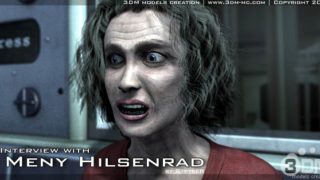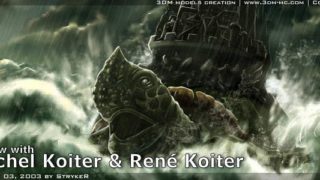
Interview with Michael Hegner
Matthew Woodhams asked Michael a few questions and it ended up being one of the best interviews ever done for Eje-Zeta. He talked about 6 essential points to follow whilst working on an independent productions and how to keep thngs simple.
|
|
Matthew Woodhams asked Michael a few questions and it ended up being one of the best interviews ever done for Eje-Zeta. He talked about 6 essential points to follow whilst working on an independent productions and how to keep thngs simple. AFilm had proved that there is a market for professional animated films outside the US. How would you compare the productions created in North America to those done in the rest of the world? The American market is huge and homogenised, and the movie industry is extremely professional. As a result the turnover and possible income on American major productions is enormous, compared to the rest of the world. On top of this, or because of this, American movies are sold and marketed very strongly all over the world, where as movies from the rest of the world are having a hard time trying to find a way into the American market. This leaves us (The “Not American filmmakers”) with generally smaller budgets and very diffuse marketing possibilities. The smaller country the worse this gets: The bigger countries like England, France and Germany does have a home market that allow expensive productions to some extend, but in Denmark the total population is 5 million people, so to do animated movies for the Danish market seems rather insane. Never the less Nordic Film and TV2, and A. Film produced the low budget 3D Feature: “Terkel in trouble” that ended up being the biggest animation hit on the Danish screens in 2005, with almost 400.000 admissions. This, plus an uncalculated sale to the rest of the world, actually turned it into a financially success. Turning all the “weaknesses” of being small and independent into a force is something we try to do on all our productions. Here is a few points that I find essential to follow: 6 ESSENTIALS WHILST WORKING ON AN INDEPENDENT PRODUCTION
|
|
|||
 |
|
Can you please share some details related to any one of your films; production time, processes that took place, estimated cost for each process, how many people are behind the project, etc. |
Hmmm… Make sure you do it because you love it and just can’t help it. If you are in it for money and fame you are definitely in the wrong spot! |
|||
|
The Ugly Duckling and Me:
Production: Co-production Magma in Ireland, Ulysses in Germany, Futurikon in France and A. Film in Denmark. Getting financing for an animated production here in Chile is always difficult. Where does the financing come from for your films? How do you present a project and what elements do you consider important when presenting a project to be well received for financing? There is an annual event here in Europe called Cartoon Movie, where all relevant people from all sides of the business meet. Here all the producers and production houses screen their new projects and get in contact with investors, distributors etc. This is the single most important event. There is also the American Film Market, and most importantly all the personal connections. How do your films export to the foreign market? Are they well received? Our films travel quite well to foreign markets. Help I’m a Fish has, to my knowledge, been sold to more than 50 countries, most of them for theatrical release. In general animated movies travels better than “normal” films. This is a huge advantage when trying to finance those movies, since they can earn money back on a potentially large number of countries. |
Help I am a Fish:
Traditional 2D with lots of CGI elements. The idea for this movie was originated by Stefan Fjeldmark who is one of the owners of A. Film. The movie was pitched everywhere, also to several investors also in the US who chose not to take part. We made a trailer before we got the money, to show the style and quality we wanted, and to sell the project. Making a fake trailer is a very good, but expensive way to develop your project. The animation was split in three bulks, the three studios. Clean up and some in-between was done in Bangkok. backgrounds in Ireland and Taiwan. Score and sound in Denmark and Germany. RELATED LINKS: |
|||

 Back in 89′ was working as an animator in Germany, but felt that it was about time to get back home to Denmark. He had been talking to two of his colleagues about setting up their our own place based in Denmark, but when he finally went back they where both working for 5 guys in a small apartment in Copenhagen. They called the place
Back in 89′ was working as an animator in Germany, but felt that it was about time to get back home to Denmark. He had been talking to two of his colleagues about setting up their our own place based in Denmark, but when he finally went back they where both working for 5 guys in a small apartment in Copenhagen. They called the place 










